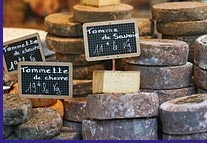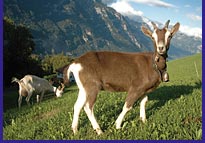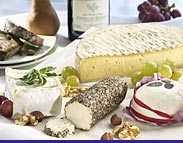 Comté, one of the first cheeses to receive AOC recognition, is steeped in French tradition. It hails from the Jura region, located on the border of Switzerland, and is made exclusively from the milk of Montbéliarde cows. Its traditional production process — it is produced year-round by small, cooperative dairies known as fruitières — has spanned generations. Aged from 6 months to a year, Comté’s appeal owes much to its ability to used for any course. It works as well with bread and wine for an evening of entertaining as it does as a slice on a sandwich. Recipes that particularly suit Comté include scalloped potatoes, soufflés, and cheesecake. (The fondue recipe in The Fomage Club Quarterly’s latest isssue uses coarsely grated Comté.)
Comté, one of the first cheeses to receive AOC recognition, is steeped in French tradition. It hails from the Jura region, located on the border of Switzerland, and is made exclusively from the milk of Montbéliarde cows. Its traditional production process — it is produced year-round by small, cooperative dairies known as fruitières — has spanned generations. Aged from 6 months to a year, Comté’s appeal owes much to its ability to used for any course. It works as well with bread and wine for an evening of entertaining as it does as a slice on a sandwich. Recipes that particularly suit Comté include scalloped potatoes, soufflés, and cheesecake. (The fondue recipe in The Fomage Club Quarterly’s latest isssue uses coarsely grated Comté.)
 Comté is a gruyère, so it can be consider a “base” taste — but it can be surprisingly nutty and fruity. With proper aging, more time in the cave can lead to a spectrum of flavors. Says Olga Dominguez of Zabar’s, “The more you keep the cheese in your mouth the more it grows.” Dominguez recommends a Comté in her Ultimate Holiday Plate. “It’s a fabulous cheese and a very safe cheese to serve. You can cook with it, you can shred it, and you can melt it — over onion soup it’s fabulous. It’s a cheese to just have in your kitchen,” she says. Its taste and facility make it a favorite in France — the country produces 50,000 tons, or 1.2 million wheels every year.
Comté is a gruyère, so it can be consider a “base” taste — but it can be surprisingly nutty and fruity. With proper aging, more time in the cave can lead to a spectrum of flavors. Says Olga Dominguez of Zabar’s, “The more you keep the cheese in your mouth the more it grows.” Dominguez recommends a Comté in her Ultimate Holiday Plate. “It’s a fabulous cheese and a very safe cheese to serve. You can cook with it, you can shred it, and you can melt it — over onion soup it’s fabulous. It’s a cheese to just have in your kitchen,” she says. Its taste and facility make it a favorite in France — the country produces 50,000 tons, or 1.2 million wheels every year.
Pate: Comté should have an ivory-colored paste that can range from pale to yellow, a variation that depends on whether it’s made from the milk from summertime or from wintertime. The “eyes” of Comté should be visible — they are the result of proper affinage and should be the size of a pea or slightly larger. If affinage is prolonged at too low of a temperature, the result will be that no eyes form. It should exhibit no cracks, blemishes or bruises.
Rind: Comté has a thin beige rind, which thickens and hardens as the cheese matures. It is rubbed with brine during aging to encourage the development of the rind mold. (Don’t be alarmed by mold on French Cheese — unless it’s dark brown or black.) Comté should be firm, and the rind gray-brown and pebbled.
Taste: Comté has a wide variety of tastes that range from fresh hazelnuts to a hint of nutmeg, and from fruity to salty. A young Comté might have a delicate buttery flavor, while and older Comté may break out with fruity, spicy and roasted flavors such as vanilla, honey or toast. Be patient while tasting, and look for the flavors to unfold gradually and lastingly in the palate — beware of any hard or semi-hard cheese that tastes bland or plasticy. You may detect its “crystals”, or minerally grains of deposits, in a more aged Comté — that’s the result of the dehydration process, and it adds a slightly salty tang to the cheese’s nuttiness. If you prefer this crunchiness, look for Comté aged at least 1½ years.
Cut: Comté originates from a wheel that is approximately 70 pounds. It should be cut as needed and the remainder kept in large pieces. At Zabar’s, for instance, the wheel is cut into quarters, and one of the quarters is cut into smaller five pound chunks that are then cut to order for the customer.
What to ask for: If possible, speak to the person responsible for selecting and obtaining the cheeses at your market. As a consumer, don’t worry about inquiring about the finer points of affinage or storage, but do take any recommendations or opinions that are offered. Also, if the market is set up for tasting, ask for a taste — they should always be offered readily upon request. Quality Brie should taste rich and mushroomy, almost meaty, and never like bland plastic.
Taking it home: Comté is a perfect cheese to have in the kitchen, so purchase it for plating (1-1½ ounces per person, or less for more cheeses) or by the pound for slicing and grating. Always serve fresh cut Comté — the longer you wait, the more you lose — with the rind attached in a hunk, wedge or strip. Dry white wines such as Sancerre, light red wine such as Beaujolais, Jura yellow wine pair well. A well-aged Comté flatters full-bodied reds, whereas sparkling wine pairs nicely with younger Comté.






